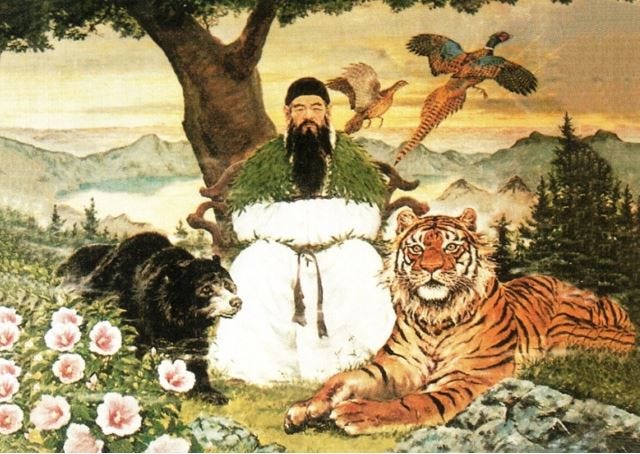Rome has Romulus and Remus, the Greeks have Gaia and Uranus, and their children Titans, and the Jews of course have their Genesis.
Koreans have the story of Dahn-guhn (단군, 檀君, ** Since all English language websites have his name as “Dangun,” I’ll use that spelling henceforth). He is considered the founder of Korea as a nation-state.

If you’re looking to take any sort of Korean history class or certification exams administered by the Korean government, this is something you have to know. I assure you; it will be on the test.
This is how the main story goes in black bullet points. The Italics in white bullet points are additional information. I thought about putting them in footnotes, but who reads footnotes in a blog?
Hwan-in (환인, 桓因), the God (or Emperor) of the Heavens, had a son who found the life on Earth desirable and wanted to rule over its peoples.
God of the Heavens says nothing of the “Creator” role.
Upon learning of his son’s desires and seeing that those peoples are good, Hwan-in decides to send down his son Hwan-woong (환웅, 桓雄) with 3 objects to help him rule them.
the 3 “heavenly” objects are: sword, mirror, and something in the shape of a water droplet.
Hwan-woong descends at Taebaek Mountain (태백산, 太白山) with 3000 cohorts, including 3 deities that oversee the wind, the rain, and the clouds.
there is a Taebaek mountain in the eastern part of South Korea, but Taebaek mountain in the legend refers to Baekdoo Mountain (백두산, 白頭山) in North Korea (the highest peak in the Korean peninsula).
Hwan-woong establishes a city near Taebaek Mountain and starts living amongst people and ruling over them.
One day, a tiger and a bear approach Hwan-woong and ask him to turn them into human forms.
this is the part of the legend that gets quoted most often.
Hwan-woong gives them a few bunches of mugwort and garlic and says, “if you eat only these and not see the sunlight for 100 days in a cave, you will become humans.”
mugwort is called 쑥 (sook) and it has a very distinct herbal smell to it. it’s long been used as a medicine and food.
Korean textbooks say it’s 쑥 and 마늘 that Hwan-woong gave to the tiger and the bear. 마늘 is garlic, BUT! garlic is indigenous to Egypt and it wasn’t introduced to Korea until the 12th century. Modern scholars believe that it was 달래 (dallae) that Hwan-woong gave to the tiger and the bear. Dallae is a very aromatic wild mountain garlic (it’s not really garlic) that grows in the spring.
The tiger reportedly gives up after a few days, but the bear endures the task for 21 days (삼칠일, 三七日 = 3 x 7 days) and became a woman. And her name was Woong-nyeo (웅녀, 熊女).
this part is the source of biggest misinformation. most people are taught that the bear endured the entire 100 days in the cave, but that’s not true. the sourcebook from which the story of Dangun originates clearly says the bear came out of the cave as a human woman in 3*7 days, meaning 21 days.
and the name Woong-nyeo literally means “bear woman.”
Woong-nyeo who couldn’t find a mate continued to pray under a tree wishing for a child of her own. Having noticed it, Hwan-woong temporarily turns into a human form and mates with Woong-nyeo.
up until this point, the story says nothing of Hwan-woong’s form.
Woong-nyeo gives birth to a boy and he is named Dangun Wang-geom (단군왕검, 檀君王儉).
Dangun, in the 25th year of the mythical Chinese Emperor Yao (堯), founds Joseon and establishes its capital city in Pyongyang, later moved to a city called Asadal (아사달).
Emperor Yao (c. 2356~2255 BCE) is mentioned in the sourcebook for cross-referencing purposes. This is the point the scholars use to date the beginning of Korea as a nation-state = 2333 BCE.
and yes, Pyongyang here is the same Pyongyang in North Korea. it is historically a very important city. the location of Asadal is not known.
Dangun ruled over Joseon for 1500 years before he “retires” into a mountain and becomes a mountain deity.
We need to clarify a few things.
In the entirety of Korean history that dates back 5000 years, there have been 2 separate Joseon kingdoms (there are 3 actually, but we’re not going to concern ourselves with the third one). One is the first ancient Korean kingdom established by Dangun. And the other is the more recent Joseon (or, Josun) I talk about frequently in my postings.
They have the same name, even in Chinese. The founder of the more recent Joseon (조선, 朝鮮) Dynasty Yi Sung-gye declared that he is naming his new country as Joseon in homage to the first ancient Korean nation-state established by Dangun. So, in modern times, we call Dangun’s Joseon as Go-Joseon (고조선, 古朝鮮) and the Yi Dynasty’s Joseon as just “Joseon.” The “go” in Gojoseon means “old” or “ancient.”
This founding myth of ancient Korea first appears in the Samguk Yusa (삼국유사, 三國遺事), Overlooked Historical Records of the Three Kingdoms, published in 1281 and written by a Buddhist monk named Il-yon (일연).
The oldest records of (Go)Joseon in Chinese history texts dates back to 7th century BCE, signifying that there was indeed a nation-state called Joseon at the time and most likely a few centuries before that, at minimum.
Modern scholars are in agreement that Dangun is not a name of a person. It is rather a name of a position—sort of Master of Religious (shamanistic) ceremonies. And Wang-geom is also thought to be a name of a position—a position of national ruler. So, in fact, we don’t have the actual name of the person who was born between Hwan-woong and Woong-nyeo.
If you’re into Korean pop culture, you will undoubtedly run into the stories of tiger and bear from time to time, and this is where it comes from.







Great details! I enjoy imagining a bear eating 쑥 and 달래. 달래 versus 마늘 makes the story so much more deeply Korean.
Wow, so happy I read this. No one teaches this one in Europe. Keep up the good work! :)